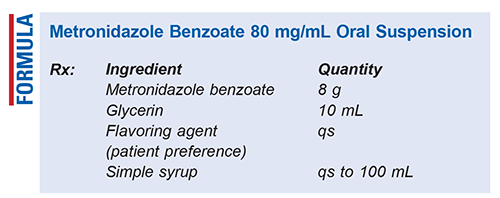US Pharm. 2023;48(4):71-72.

Method of Preparation: Calculate the amount of each ingredient required for the total amount to be prepared. Weigh out the metronidazole benzoate and place it in the mortar; triturate until finely powdered. Weigh out the glycerin and levigate the powder with a small amount of glycerin until a smooth paste forms. Add the remaining glycerin and the flavoring agent; then transfer the mixture to a calibrated bottle. Rinse the mortar with simple syrup and bring the final volume to 100 mL. Shake vigorously until the powder is evenly suspended.
Use: Metronidazole benzoate oral suspension is commonly used to treat bacterial infections and intestinal parasites.
Packaging: Package in a tight, light-resistant container. Store at controlled room temperature.
Labeling: Keep out of reach of children. Keep refrigerated. Protect from light. Shake well. Discard after ____ [time period].
Stability: The USP default beyond-use date for nonaqueous oral liquids is 90 days when the preparation is stored at controlled room temperature or in a refrigerator.1
Quality Control: Quality-control assessments can include weight/volume, pH, specific gravity, active drug assay, color, rheologic properties/pourability, physical observation, and physical stability (discoloration, foreign materials, gas formation, mold growth).2
Discussion: Metronidazole is effective against anaerobic bacteria and protozoa. As a nitroimidazole, it can target obligate anaerobes and hinder DNA synthesis, making it a useful treatment for a wide range of infections (e.g., sexually transmitted infections, genitourinary infections, parasitic infections, bacterial infections). Metronidazole can also prevent infections before, during, and after intestinal surgery. Common side effects include nausea, vomiting, diarrhea, and abdominal discomfort; more severe reactions, such as convulsive seizures and peripheral neuropathy, have also occurred.
Metronidazole benzoate (C13H13N3O4, MW 275.2605), a benzoate ester resulting from the formal condensation of benzoic acid with the hydroxy group of metronidazole, is a crystalline, white or slightly yellowish powder. Although metronidazole benzoate is not very soluble in water, it can dissolve in dichloromethane and acetone and is slightly soluble in alcohol. It has a pKa of 3.27 and a melting point of 100°C. Metronidazole is available as capsules, tablets, injections, gels, creams, and lotions. Flagyl tablets contain 250 mg or 500 mg of metronidazole along with inactive ingredients (cellulose, FD&C Blue No. 2 Lake, hydroxypropyl cellulose, hypromellose, polyethylene glycol, stearic acid, and titanium dioxide).3
Glycerin (C3H8O3, MW 92.09) is a clear, odorless liquid with a sweet taste that is 0.6 times sweeter than sucrose. It is 95% soluble in water, ethanol, and methanol but only slightly soluble in oils, benzene, and chloroform. To maintain its quality, glycerin should be kept in an airtight container in a cool, dry environment; it is hygroscopic and may crystallize if stored at low temperatures. Glycerin is versatile, serving as an antimicrobial preservative, emollient, humectant, plasticizer, solvent, and sweetening/tonicity agent. Its specific application varies depending on the formulation in which it is used. Glycerin acts as a humectant and emollient in topical formulations, keeping surfaces moist by drawing in moisture. It is also used as a preservative and sweetening agent in oral solutions.4
Simple syrup is a thick, viscous solution of sucrose in purified water that typically contains a high concentration of sucrose. The concentration varies according to differences in regulatory standards; for example, USP allows up to 85% w/w sucrose. Simple syrup has a sweet taste and flavor, making it a popular sweetener and vehicle in various applications. Sucrose (C12H22O11, MW 342.30) is a white, crystalline powder or crystal derived from sugarcane and other sources. It is largely insoluble in chloroform but is soluble in water at a rate of 1 in 0.5 at 20°C, and it is highly stable at room temperature. Sucrose syrup, which contains 50% to 67% w/w sucrose, is frequently used as a tablet-coating agent and as a vehicle in liquid dosage forms; in oral suspensions, it also functions as a flavoring agent.5
REFERENCES
1. U.S. Pharmacopeia/National Formulary [current revision]. Rockville, MD: U.S. Pharmacopeial Convention, Inc; September 2022.
2. Allen LV Jr. Standard operating procedure for performing physical quality assessment of oral and topical liquids. IJPC. 1999;3:146-147.
3. Metronidazole (tablets) product information. Congers, NY: Chartwell Molecules LLC; April 2020.
4. Glycerin. In: Rowe RC, Sheskey PJ, Owen SC, eds. Handbook of Pharmaceutical Excipients. 5th ed. Washington, DC: American Pharmaceutical Association; 2006:301-303.
5. Sucrose. In: Rowe RC, Sheskey PJ, Owen SC, eds. Handbook of Pharmaceutical Excipients. 5th ed. Washington, DC: American Pharmaceutical Association; 2006:744-747.
The content contained in this article is for informational purposes only. The content is not intended to be a substitute for professional advice. Reliance on any information provided in this article is solely at your own risk.
To comment on this article, contact rdavidson@uspharmacist.com.





